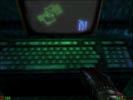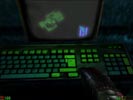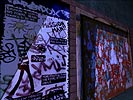
Original Link: https://www.anandtech.com/show/258
When S3 announced its return to the graphics chipset industry last year AnandTech couldn’t help but feel nostalgic about the power player’s return to the lime light. At the time, their Savage3D product was supposed to take them the distance to make S3 the elusive "Voodoo2-killer," but as we now all know, in 1998, the killer’s cameo never made it to the big screen, and S3’s two year long project went down in blazes. The Savage3D was a general failure in comparison to nVidia’s hot product, the TNT, however the failure of the Savage3D wasn’t because of a weak chipset, or a poorly performing exhibition, rather the Savage3D was nothing more than a premature baby. Had S3 given the Savage3D time to mature, the product might have grown into something the market would be able to assimilate, unfortunately, not even the low price tag could keep the Savage3D’s sales up to even a reasonable point.
After companies like Diamond Multimedia dropped their previously proposed Savage3D parts things seem to slide down hill for S3. It wasn’t as if S3 didn’t have the brains to put out a killer product, because they did, and it wasn’t as if S3 didn’t have the manpower to make the Savage3D a stellar solution, because they definitely did, if anything, it seemed like the hype surrounding the search for the "Voodoo2-killer" of 1998 caused S3 to be overconfident in their Savage3D and jump the gun with its release. The release was plagued by poor driver support, sub par quality testing on the Savage3D chips themselves, and an overall poor reflection on S3 as a company.
When AnandTech previewed the Savage3D, the results looked promising, however when AnandTech reviewed the final revision Savage3D, the fact that the problems from the original preview generally remained as pronounced in the final review soured AnandTech’s taste on the entire Savage3D experience. The only company to hold on to S3’s vision with the Savage3D was Hercules, who happened to be the first to jump the gun with a release and have supported the chip ever since. Other than Hercules tending to S3’s unfortunate niche market, the Savage3D has been nothing but dead water, allowing the rest of the market to easily be gobbled up by nVidia, 3Dfx, and Matrox in the 3D wars of late 1998.
Then came 1999, the year of competition, and the start of the search for the dominant force in the 3D gaming market. Last year showed us all that a standalone 3D accelerator could rise to the top of the market, however it also showed us that the standalone 3D accelerator market is a niche market, and does happen to limit itself greatly from a large number of potential customers. The nVidia TNT was the perfect example that a 2D/3D combo solution can succeed, simply because the 2D/3D TNT did just that, succeed beyond belief in spite of nVidia’s inflation of the specifications of their over-hyped product. What part does S3 play in all this? Learning from their mistakes, S3 is up for another try, this time, instead of going back to the drawing boards, S3 has decided to improve on a design that already had great potential, and the result is everything the Savage3D should have been back in 1998. When Diamond Multimedia came to AnandTech with an offer to take a look at their latest S3 based product, AnandTech scheduled an appointment with the company that flat out rejected S3 with their original design, the Savage3D, yet was eager to show off their latest concoction, the Savage4 at full speed. What was so great about S3’s latest product that would make Diamond change their minds about S3’s products? The same thing that AnandTech was hoping for from S3 at the start of the Savage3D hype.
For starters: What is AGP?
There isn't a computer gamer out there that hasn't heard the term AGP, or Accelerated Graphics Port, used in a requirements listing on the back of the latest game they've been eyeing. But what is AGP? It isn't rare that our favorite three letter acronyms quickly become lost in their household connotations and we eventually forget what it is they are actually providing us with, if anything at all (the letters MMX come to mind). So what is AGP? (If you're already familiar with the basics of AGP you'll want to skip past this part)
AGP is, according to Intel, a "high performance, component level interconnect targeted at 3D graphical display applications and is based on a set of performance extensions or enhancements to PCI." Basically it is a specialized bus whose sole purpose is to provide "housing" for 2D/3D accelerators in your AGP compatible system.
When operating in its currently standard 2X transfer mode, the AGP bus allows for peak transfer rates of up to 528MB/s up from the 132MB/s of the PCI bus. Using the faster transfer rates the AGP bus allows your AGP compliant computer can store those extremely large textures that games may use in your system memory and retrieve them quickly instead of having to use your graphics card's limited local memory for texture storage and retrieval. What happens when a non-AGP graphics card receives a texture that is larger than its local memory? The same thing that happens when your system runs out of local memory, it begins swapping, but in this case, instead of swapping to your hard disk, your graphics card will perform texture swapping with your system memory which, with the absence of the high speed AGP bus, slows performance down tremendously. This concept of AGP texturing is made possible by the hardware behind it, which is commonly referred to by the acronym GART, or Graphics Address Remapping Table. The function of the GART is basically do allow for the hardware to access large texture maps as single data objects in system memory, permitting your AGP card and software using the AGP bus to access the same memory addresses.
The second major feature of AGP which will briefly be alluded to will be the ability of AGP compliant graphics adapters to manipulate the textures it stores in the system memory directly as opposed to retrieving them and processing all the manipulations locally. This process, known as Direct Memory Execution, or DIME, allows memory intensive texture-mapping procedures to be performed within the spacious system memory rather than in the restrictive graphics card's local memory.
AGP a Reality?
If you can think back to the release of Intel's first AGP chipset, the i440LX, one of the most commonly voiced criticisms of the move to AGP graphics accelerators was that no games would take advantage of AGP or AGP texturing for that matter. Although the design was wonderful in theory, in application it boasted a relatively small performance improvement in the real world tests of the time. Even today, playing a game of Quake 2 doesn't really stress the amount of memory on most current generation 3D accelerators. It is because of this assumption, that the current wave and the next generation in 3D games won't truly require support for AGP texturing (the ability to use the AGP bus as a means of transferring textures to/from system memory) that companies like 3Dfx have stuck to either 100% PCI solutions (i.e. Voodoo2) or poorly implemented AGP specifications (i.e. Banshee/Voodoo3) that don't allow for AGP texturing in light of keeping costs down. Is that how things truly are?
Here's a reality check, they aren't. It's very easy to understand, more detailed textures simply look better and, unfortunately, more detailed textures do take up more space than those of lesser detail. This brings up the whole image quality vs performance debate, however that's something that we won't get in to for now, instead we'll leave the discussion at this comparison: regardless of how beautiful a sunset is, if you're blind to a point where all you can distinguish is general color changes, the sunset has virtually no effect on you. That may be an extreme example, but it's a quick end to an argument that could take pages upon pages to even come close to resolving. After playing a game that has extremely detailed textures on a single 12MB Voodoo2 at 800 x 600, then playing the same game at 800 x 600 on an AGP nVidia Riva TNT based graphics card, you can truly begin to notice the difference. While older games such as Quake 2 undoubtedly run beautifully on a single Voodoo2 and run like a dream on a dual Voodoo2 SLI setup, there comes a point where even 24MB of memory (SLI Voodoo2's) isn't enough to cover the demands of the upcoming games. Remember when you heard all of the industry analysts talking about how AGP would eventually be put to good use in the gaming industry? That time is almost upon us, and it's time for companies to realize that AGP texturing and taking full advantage of the specification's capabilities is something all of their video products should do. The technology is there, and it's about time that we start using it. Luckily companies like nVidia, Matrox, and S3 have already taken the first steps in that direction…but it seems as if there is more that could be done…
Step two to better Texture Quality
So we have these larger textures being stored in system memory after being transferred over the AGP bus, and these textures are put to work using the DIME specification, but where does S3 fit into this all? Instead of relying solely on the benefits of AGP to allow for game developers to toss incredible amounts of textures at the graphics subsystem, S3 realized that although AGP allows for a large portion of your system memory to be used for texture storage and manipulation, there is still a limit to the effectiveness of the technology. Primarily, the amount of system memory available for AGP to make use of. The next logical step in this progression would be to somehow compress the textures to a point that even larger, and higher quality, textures could be stored in the same amount of system memory, therefore giving us step two, to better texture quality: S3's Texture Compression.
S3's 6:1 compression ratio provided for by the S3 Texture Compression (S3TC) technology allows for the seamless integration of compression technology, with no noticeable visual penalty, due to its full support in Microsoft's DirectX 6.0. S3TC isn't something S3 cooked up on the side, it is a fully licensable and readily available compression algorithm that is supported in DirectX 6.0, it's about time a company realized that proprietary isn't the way to go to make your presence known in the market. Just to get a vague idea of the capabilities of S3TC, while the Voodoo2 is limited to texture sizes of 256 x 256 pixels, a S3TC texture is limited to 2048 x 2048 pixel textures.
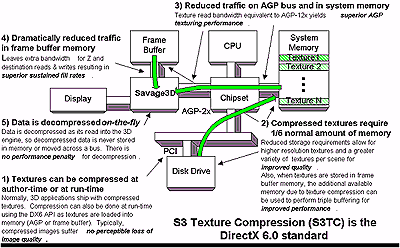
Copyright 1999 S3
Coupled with full AGP 4X support, to be taken advantage of in Intel's 820 Camino chipset, support for the S3TC standard and improved overall quality are the founding fathers of S3's latest concoction, the Savage4.
Savage4 Specs
High-Performance 2D/3D/Video Accelerator
- Floating point triangle setup engine
- Single cycle 3D architecture
- 8M triangles/second setup engine
- 128-bit rendering pipeline
- 140M pixels/second trilinear fill rate
- Full AGP 4X/2X, including sideband addressing and execute mode
- S3 DX6 texture compression (S3TC)
- Flat panel desktop monitor support
- High quality DVD video playback
3D Rendering Features
- Single-pass multiple textures
- Hardware bump mapping
- Full scene anti-aliasing
- Anisotropic filtering
- 8-bit stencil buffer
- Single cycle trilinear filtering
- 32-bit true color rendering
- Specular lighting and diffuse shading
- Alpha blending modes
- MPEG-2 video textures
- Vertex and table fog
- 16- or 24-bit Z-buffering
- Sprite anti-aliasing, reflection mapping, texture morphing, shadows, procedural textures and atmospheric effects
Motion Video Architecture
- High quality up/down scalar
- Planar to packed format conversion
- Motion compensation for full speed DVD playback
- Hardware subpicture blending and highlights
- Multiple video windows for video conferencing
- Contrast, hue, saturation, brightness and gamma controls
- 60MHz VIP video port allows HDTV resolutions
- Digital port for NTSC/PAL TV encoders
High Speed Memory Bus
- 125/143 MHz memory interface
- 2 to 32 MB frame buffer
- 1Mx16 or 2Mx32 or 4Mx16 SDRAMs
- 256Kx32 or 512Kx32 or 1Mx32 SGRAMs
- SO-DIMM memory upgrade
- Block write support
2D Acceleration Features
- Highly optimized 128-bit graphics engine
- Full featured 2D engine for acceleration of BitBLT, rectangle fill, line draw, polygon fill, panning/scrolling and hardware cursor
- 8, 16, and 32 bpp mode acceleration
Flat Panel Desktop Monitor Support
- 24-bit digital interface for flat panel encoders
- Auto-expansion and centering for VGA text and graphics modes
- Support for all resolutions up to 1280x1024
Full Software Support
- Drivers for major operating systems and APIs: [Windows. 9x, Windows NT 4.0/5.0, Windows 3.x and OS/2. 2.1/3.0 (WarpTM), Direct3DTM, DirectDrawTM and DirectShowTM, OpenGLTM ICD for Windows 9x and NT]
- Comprehensive SDK, utilities and ISV tools
- ISV and bundling programs
Additional Features
- 300MHz RAMDAC with gamma correction
- I2C serial bus and flash ROM support
- ACPI and PCI power management
- Hardware and BIOS support for VESA timings and DDC monitor communications
- PCI 2.2 bus support including bus mastering
- 27x27mm PBGA with 336 balls
- 2.5V core with 3.3V/5V tolerant I/O
The Test
Diamond Multimedia was generous enough to pay AnandTech another visit, this time with a Savage4 product ready and waiting, in order to give us a sneak peak at the performance of their upcoming Diamond Stealth Savage4 product. The alpha release of the board AnandTech got to test ran at full speed (125MHz core / 143MHz memory clock), so the only performance increases that can be made now are those that can be achieved via driver tweaking which still leaves room for considerable improvement. Diamond wouldn't allow AnandTech to publish comparison benchmarks, so to get a vague idea of the performance of the Savage4 here are some preview performance numbers.
The test systems were a Pentium III running at 500MHz, a Pentium II running at 266MHz, and a Celeron running at 266MHz w/ 0KB L2 cache. All benchmarks were run on an ABIT BX6 Revision 2.0, with a Western Digital 8.4GB UDMA Caviar HDD, 64MB of PC100 SDRAM, running Windows 98. No foreign drivers were present during the benchmarking. All benchmarks were run using the Pentium III 500 unless otherwise noted.
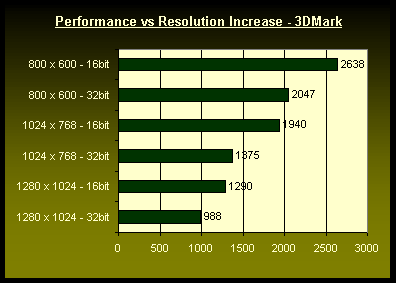
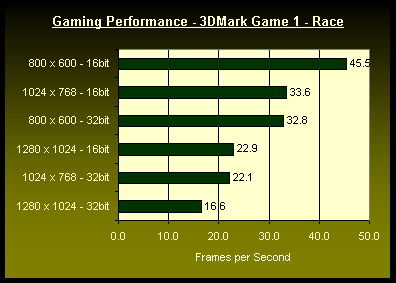
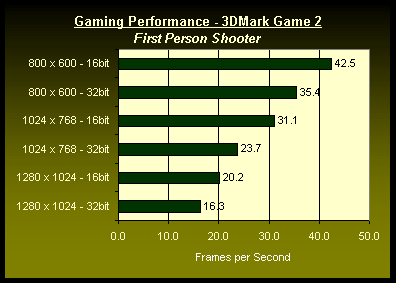
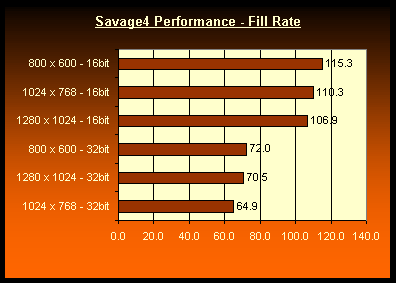
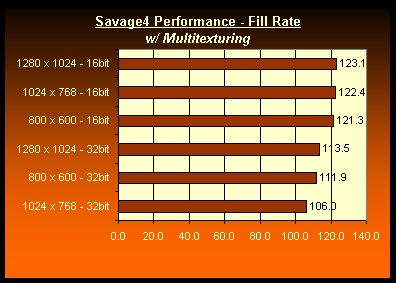
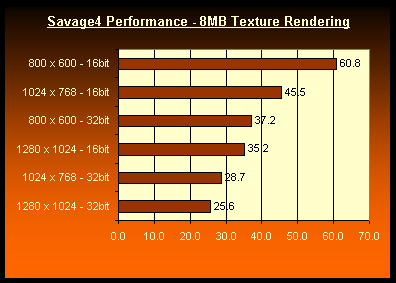
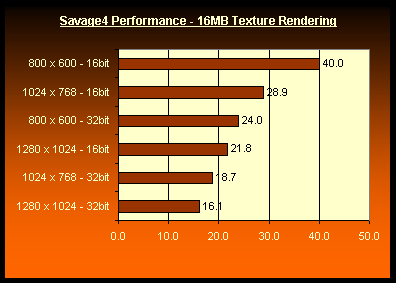
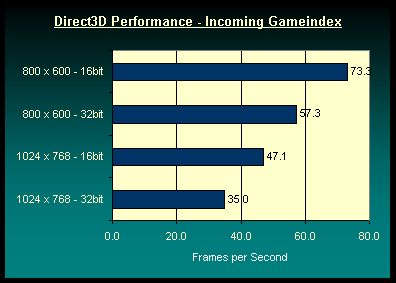
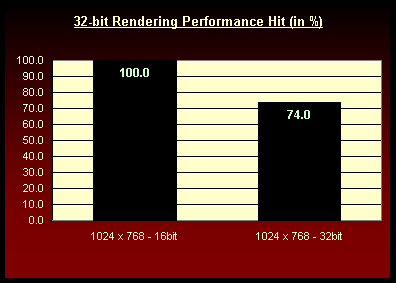
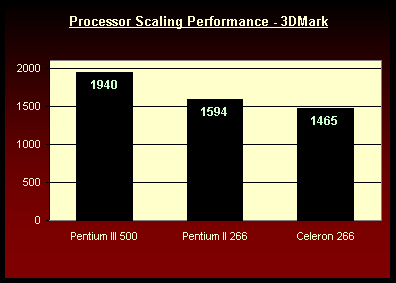
Image Quality Example
Final Words
The problems AnandTech experienced with the original Savage3D seemed to be completely absent from the quick 4 hour experience Diamond let us have in the lab, definitely a promising sign. It seems as if S3's design has finally matured to the point where a release makes sense, and if Diamond is willing to put their name behind the product, it should be a noticeable improvement over S3's last attempt at a rise to 3D power.
The 2D image quality of Diamond's Savage4 preview board was greater than most TNT boards, however it was still not up to par with Matrox's G200 and definitely not up to par with Number 9's Revolution IV. Luckily, for those 2D image quality fanatics out there with larger monitors that are very sensitive to quality variations at higher refresh rates, Number 9, the 2D quality king, has announced that they'll be working on their own Savage4 product so you may want to keep your eyes open for them as well.
As you can probably guess, the Savage4 isn't going to be 1999's "Voodoo3-killer" rather, it will be what Intel's i740 was during its quick rise to fame, a standard raising product that will make the low cost market smile at the beauty $100 can buy. Although Diamond officially quoted AnandTech a sub $150 price for the Savage4, you can expect actual prices to be much lower than $150 if the Savage4 is going to succeed.
Should you choose a Savage4 over something like a Voodoo2 while the performance difference between the two isn't that great? A year ago the answer would have been a bit on the shaky side, however the time has come to move on from PCI 3D accelerators and S3's Savage4, with its AGP 4X support and S3 Texture Compression feature make it a more desirable solution in the long run. The Savage4 isn't the best performer, but it isn't the worst performer, it should provide gamers that pursue it with a luscious batch of eye candy that will make even the most performance hungry gamers turn heads, that's the beauty of S3TC. The only consideration left now is whether or not game developers will begin to truly harness the power of S3TC, let's hope, for S3's sake, that games like Unreal Tournament and Quake 3 Arena do more than just list themselves as supporting S3TC.

